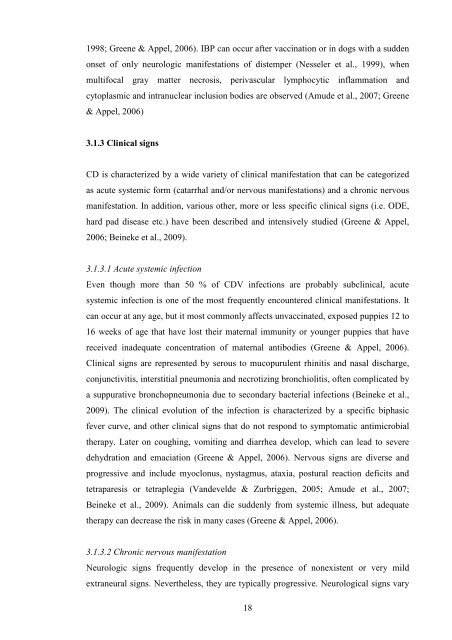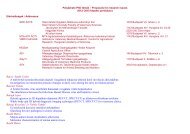PhD Thesis Demeter Zoltan
PhD Thesis Demeter Zoltan
PhD Thesis Demeter Zoltan
You also want an ePaper? Increase the reach of your titles
YUMPU automatically turns print PDFs into web optimized ePapers that Google loves.
1998; Greene & Appel, 2006). IBP can occur after vaccination or in dogs with a sudden<br />
onset of only neurologic manifestations of distemper (Nesseler et al., 1999), when<br />
multifocal gray matter necrosis, perivascular lymphocytic inflammation and<br />
cytoplasmic and intranuclear inclusion bodies are observed (Amude et al., 2007; Greene<br />
& Appel, 2006)<br />
3.1.3 Clinical signs<br />
CD is characterized by a wide variety of clinical manifestation that can be categorized<br />
as acute systemic form (catarrhal and/or nervous manifestations) and a chronic nervous<br />
manifestation. In addition, various other, more or less specific clinical signs (i.e. ODE,<br />
hard pad disease etc.) have been described and intensively studied (Greene & Appel,<br />
2006; Beineke et al., 2009).<br />
3.1.3.1 Acute systemic infection<br />
Even though more than 50 % of CDV infections are probably subclinical, acute<br />
systemic infection is one of the most frequently encountered clinical manifestations. It<br />
can occur at any age, but it most commonly affects unvaccinated, exposed puppies 12 to<br />
16 weeks of age that have lost their maternal immunity or younger puppies that have<br />
received inadequate concentration of maternal antibodies (Greene & Appel, 2006).<br />
Clinical signs are represented by serous to mucopurulent rhinitis and nasal discharge,<br />
conjunctivitis, interstitial pneumonia and necrotizing bronchiolitis, often complicated by<br />
a suppurative bronchopneumonia due to secondary bacterial infections (Beineke et al.,<br />
2009). The clinical evolution of the infection is characterized by a specific biphasic<br />
fever curve, and other clinical signs that do not respond to symptomatic antimicrobial<br />
therapy. Later on coughing, vomiting and diarrhea develop, which can lead to severe<br />
dehydration and emaciation (Greene & Appel, 2006). Nervous signs are diverse and<br />
progressive and include myoclonus, nystagmus, ataxia, postural reaction deficits and<br />
tetraparesis or tetraplegia (Vandevelde & Zurbriggen, 2005; Amude et al., 2007;<br />
Beineke et al., 2009). Animals can die suddenly from systemic illness, but adequate<br />
therapy can decrease the risk in many cases (Greene & Appel, 2006).<br />
3.1.3.2 Chronic nervous manifestation<br />
Neurologic signs frequently develop in the presence of nonexistent or very mild<br />
extraneural signs. Nevertheless, they are typically progressive. Neurological signs vary<br />
18
















